ВУЗ: Не указан
Категория: Не указан
Дисциплина: Не указана
Добавлен: 01.04.2021
Просмотров: 1559
Скачиваний: 7
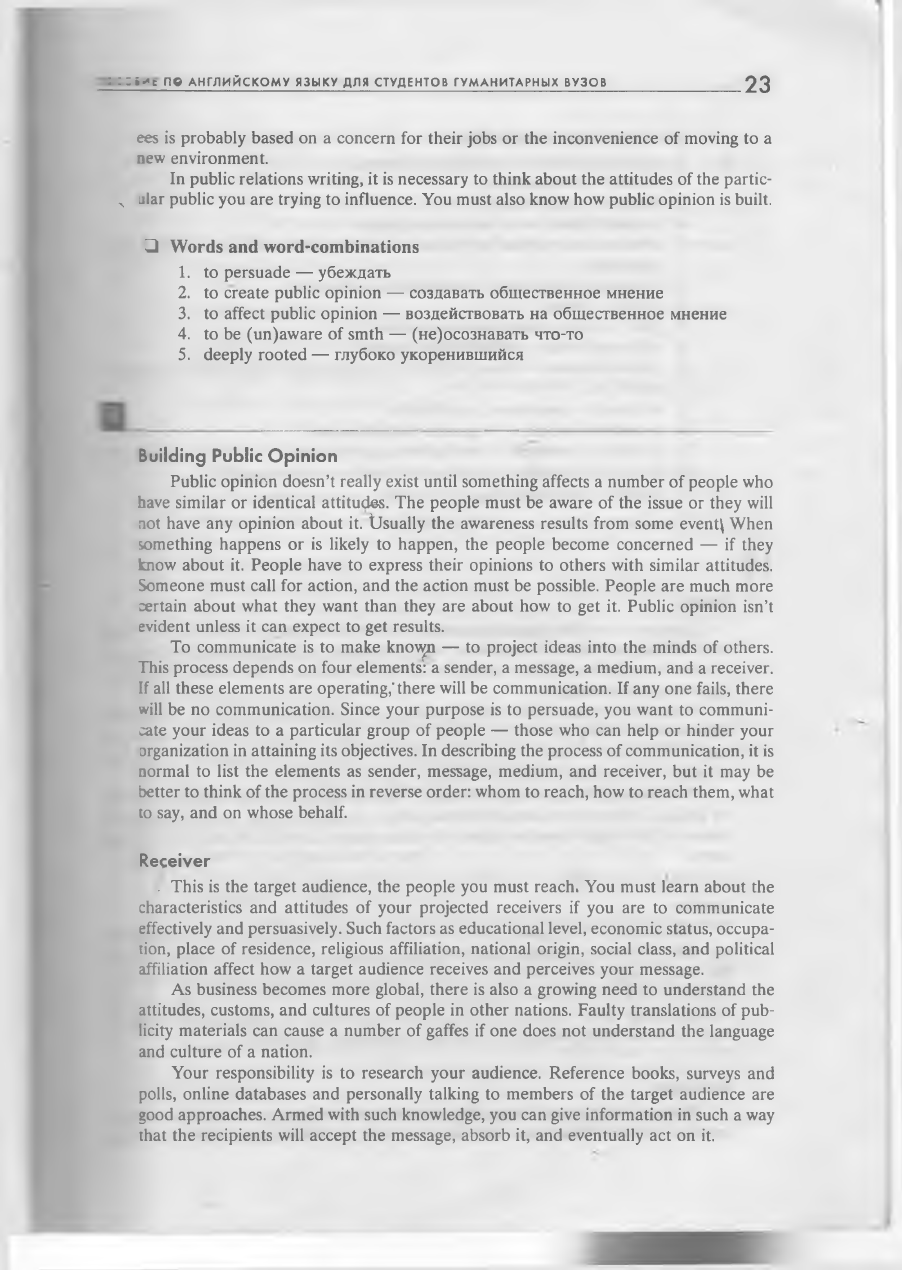
: :
Z l - ' t
П О А Н Г Л И Й С К О М У Я З Ы К У д л я с т у д е н т о в г у м а н и т а р н ы х в у з о в
23
ees is probably based on a concern for their jobs or the inconvenience of moving to a
new environment.
In public relations writing, it is necessary to think about the attitudes of the partic-
x clar public you are trying to influence. You must also know how public opinion is built.
□ Words and word-combinations
1. to persuade — убеждать
2. to create public opinion — создавать общественное мнение
3. to affect public opinion — воздействовать на общественное мнение
4. to be (un)aware of smth — (не)осознавать что-то
5. deeply rooted — глубоко укоренившийся
Building Public Opinion
Public opinion doesn’t really exist until something affects a number of people who
have similar or identical attitudes. The people must be aware of the issue or they will
not have any opinion about it. Usually the awareness results from some event^ When
something happens or is likely to happen, the people become concerned — if they
know about it. People have to express their opinions to others with similar attitudes.
Someone must call for action, and the action must be possible. People are much more
certain about what they want than they are about how to get it. Public opinion isn’t
evident unless it can expect to get results.
To communicate is to make knov^n — to project ideas into the minds of others.
This process depends on four elements: a sender, a message, a medium, and a receiver.
If all these elements are operating,'there will be communication. If any one fails, there
will be no communication. Since your purpose is to persuade, you want to communi
cate your ideas to a particular group of people — those who can help or hinder your
organization in attaining its objectives. In describing the process of communication, it is
normal to list the elements as sender, message, medium, and receiver, but it may be
better to think of the process in reverse order: whom to reach, how to reach them, what
to say, and on whose behalf.
Receiver
. This is the target audience, the people you must reach, You must learn about the
characteristics and attitudes of your projected receivers if you are to communicate
effectively and persuasively. Such factors as educational level, economic status, occupa
tion, place of residence, religious affiliation, national origin, social class, and political
affiliation affect how a target audience receives and perceives your message.
As business becomes more global, there is also a growing need to understand the
attitudes, customs, and cultures of people in other nations. Faulty translations of pub
licity materials can cause a number of gaffes if one does not understand the language
and culture of a nation.
Your responsibility is to research your audience. Reference books, surveys and
polls, online databases and personally talking to members of the target audience are
good approaches. Armed with such knowledge, you can give information in such a way
that the recipients will accept the message, absorb it, and eventually act on it.
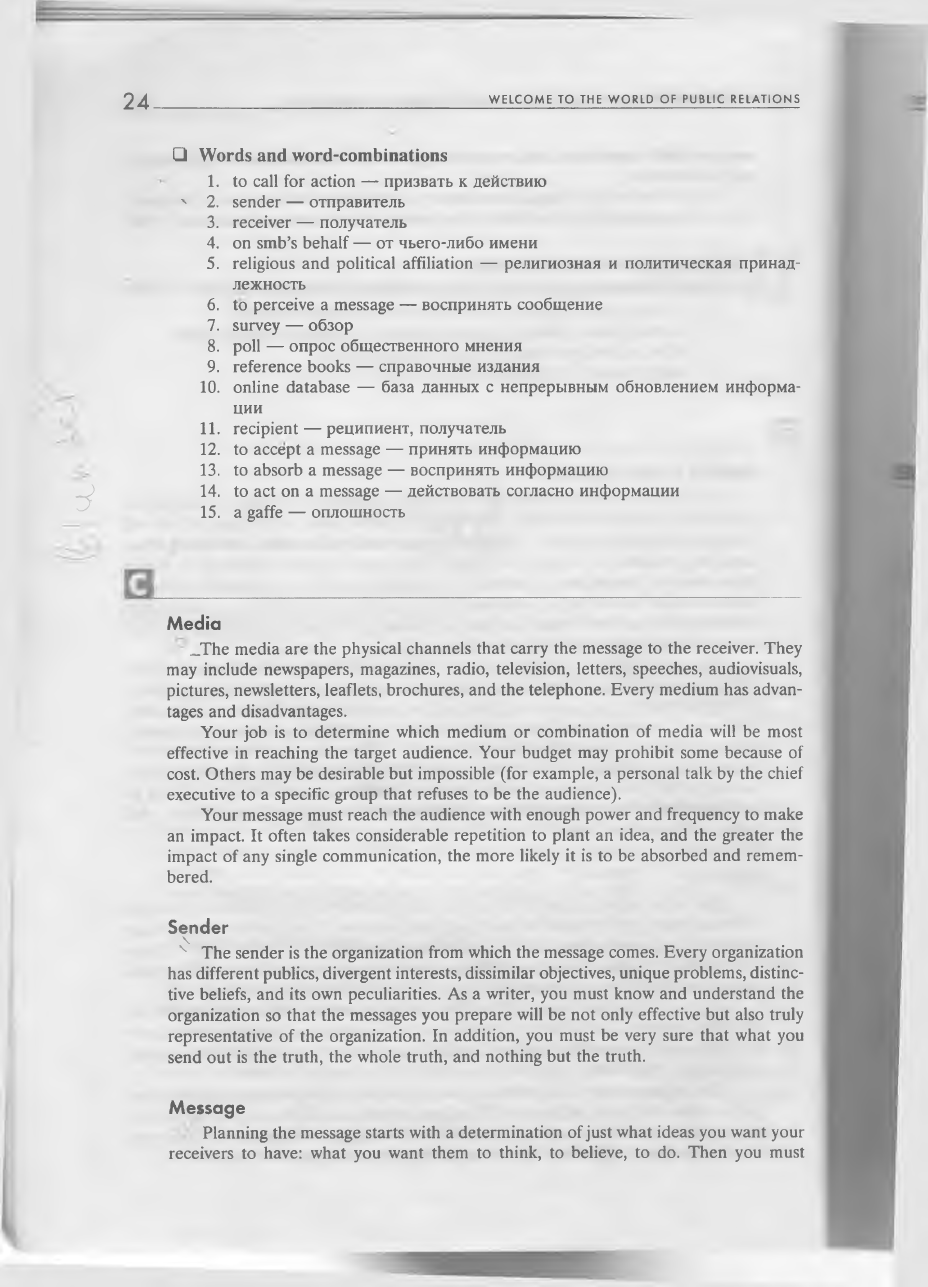
□ Words and word-combinations
1. to call for action — призвать к действию
x
2. sender — отправитель
3. receiver — получатель
4. on smb’s behalf — от чьего-либо имени
5. religious and political affiliation — религиозная и политическая принад
лежность
6. to perceive a message — воспринять сообщение
7. survey — обзор
8. poll — опрос общественного мнения
9. reference books — справочные издания
10. online database — база данных с непрерывным обновлением информа
ции
11. recipient — реципиент, получатель
12. to accept a message — принять информацию
13. to absorb a message — воспринять информацию
14. to act on a message — действовать согласно информации
15. a gaffe — оплошность
2
4
____________________________________________________________________________________ W E L C O M E T O T H E W O R L D O F P U B L I C R E L A T I O N S
в
Media
_The media are the physical channels that carry the message to the receiver. They
may include newspapers, magazines, radio, television, letters, speeches, audiovisuals,
pictures, newsletters, leaflets, brochures, and the telephone. Every medium has advan
tages and disadvantages.
Your job is to determine which medium or combination of media will be most
effective in reaching the target audience. Your budget may prohibit some because of
cost. Others may be desirable but impossible (for example, a personal talk by the chief
executive to a specific group that refuses to be the audience).
Your message must reach the audience with enough power and frequency to make
an impact. It often takes considerable repetition to plant an idea, and the greater the
impact of any single communication, the more likely it is to be absorbed and remem
bered.
Sender
\
4
The sender is the organization from which the message comes. Every organization
has different publics, divergent interests, dissimilar objectives, unique problems, distinc
tive beliefs, and its own peculiarities. As a writer, you must know and understand the
organization so that the messages you prepare will be not only effective but also truly
representative of the organization. In addition, you must be very sure that what you
send out is the truth, the whole truth, and nothing but the truth.
Message
Planning the message starts with a determination of just what ideas you want your
receivers to have: what you want them to think, to believe, to do. Then you must
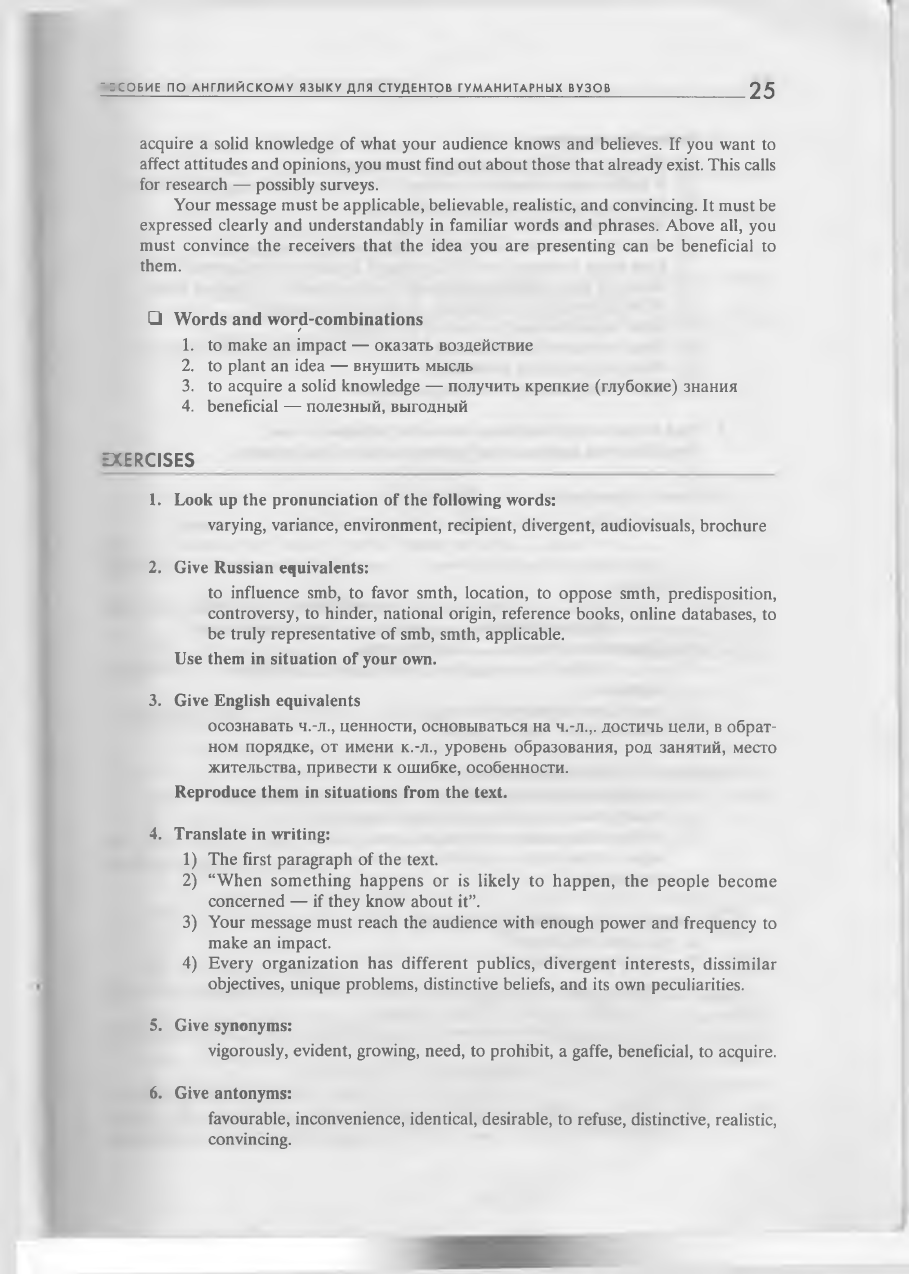
~ : С О Б И Е П О А Н Г Л И Й С К О М У Я З Ы К У Д Л Я С Т У Д Е Н Т О В Г У М А Н И Т А Р Н Ы Х
в у з о в
25
acquire a solid knowledge of what your audience knows and believes. If you want to
affect attitudes and opinions, you must find out about those that already exist. This calls
for research — possibly surveys.
Your message must be applicable, believable, realistic, and convincing. It must be
expressed clearly and understandably in familiar words and phrases. Above all, you
must convince the receivers that the idea you are presenting can be beneficial to
them.
□ Words and word-combinations
/
1. to make an impact — оказать воздействие
2. to plant an idea — внушить мысль
3. to acquire a solid knowledge — получить крепкие (глубокие) знания
4. beneficial — полезный, выгодный
EXERCISES
1. Look up the pronunciation of the following words:
varying, variance, environment, recipient, divergent, audiovisuals, brochure
2. Give Russian equivalents:
to influence smb, to favor smth, location, to oppose smth, predisposition,
controversy, to hinder, national origin, reference books, online databases, to
be truly representative of smb, smth, applicable.
Use them in situation of your own.
3. Give English equivalents
осознавать ч.-л., ценности, основываться на ч.-л.,. достичь цели, в обрат
ном порядке, от имени к.-л., уровень образования, род занятий, место
жительства, привести к ошибке, особенности.
Reproduce them in situations from the text.
4. Translate in writing:
1) The first paragraph of the text.
2) “When something happens or is likely to happen, the people become
concerned — if they know about it”.
3) Your message must reach the audience with enough power and frequency to
make an impact.
4) Every organization has different publics, divergent interests, dissimilar
objectives, unique problems, distinctive beliefs, and its own peculiarities.
5. Give synonyms:
vigorously, evident, growing, need, to prohibit, a gaffe, beneficial, to acquire.
6
. Give antonyms:
favourable, inconvenience, identical, desirable, to refuse, distinctive, realistic,
convincing.
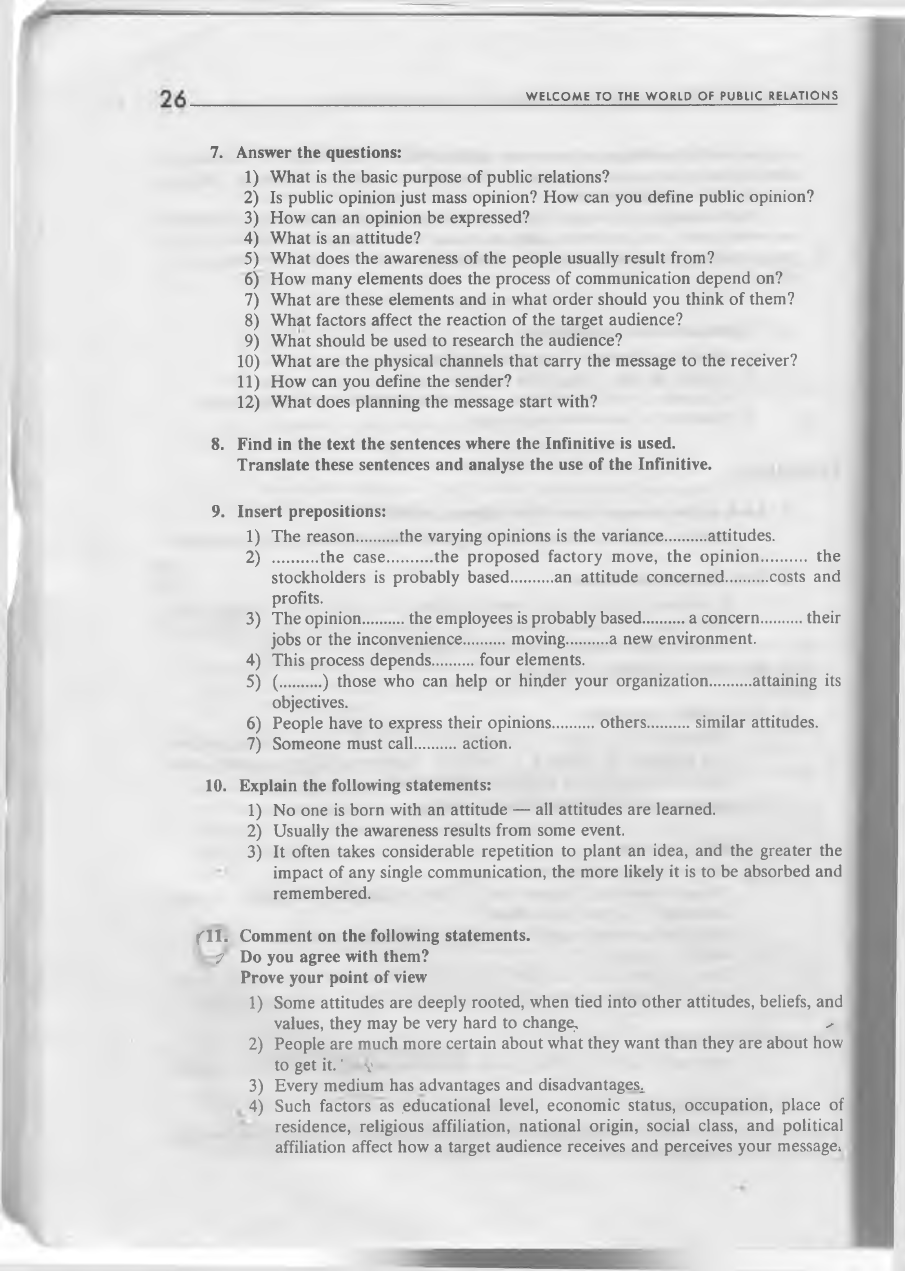
W E L C O M E T O T H E W O R L D O F P U B L I C R E L A T I O N S
7. Answer the questions:
1
2
3
4
5
6
7
8
9
10
11
12
What is the basic purpose of public relations?
Is public opinion just mass opinion? How can you define public opinion?
How can an opinion be expressed?
What is an attitude?
What does the awareness of the people usually result from?
How many elements does the process of communication depend on?
What are these elements and in what order should you think of them?
What factors affect the reaction of the target audience?
What should be used to research the audience?
What are the physical channels that carry the message to the receiver?
How can you define the sender?
What does planning the message start with?
8
. Find in the text the sentences where the Infinitive is used.
Translate these sentences and analyse the use of the Infinitive.
9. Insert prepositions:
1) The reason......... the varying opinions is the variance..........attitudes.
2)
the case...........the proposed factory move, the opinion........... the
stockholders is probably based......... an attitude concerned..........costs and
profits.
3) The opinion......... the employees is probably based...........a concern.......... their
jobs or the inconvenience......... moving...........a new environment.
4) This process depends......... four elements.
5) (......... ) those who can help or hinder your organization..........attaining its
objectives.
6) People have to express their opinions......... others...........similar attitudes.
7) Someone must call......... action.
10. Explain the following statements:
1) No one is born with an attitude — all attitudes are learned.
2) Usually the awareness results from some event.
3) It often takes considerable repetition to plant an idea, and the greater the
impact of any single communication, the more likely it is to be absorbed and
remembered.
( 11. Comment on the following statements.
7
Do you agree with them?
Prove your point of view
1) Some attitudes are deeply rooted, when tied into other attitudes, beliefs, and
values, they may be very hard to change^
✓
2) People are much more certain about what they want than they are about how
to get i t.'
v
3) Every medium has advantages and disadvantages^.
4) Such factors as educational level, economic status, occupation, place of
residence, religious affiliation, national origin, social class, and political
affiliation affect how a target audience receives and perceives your message»
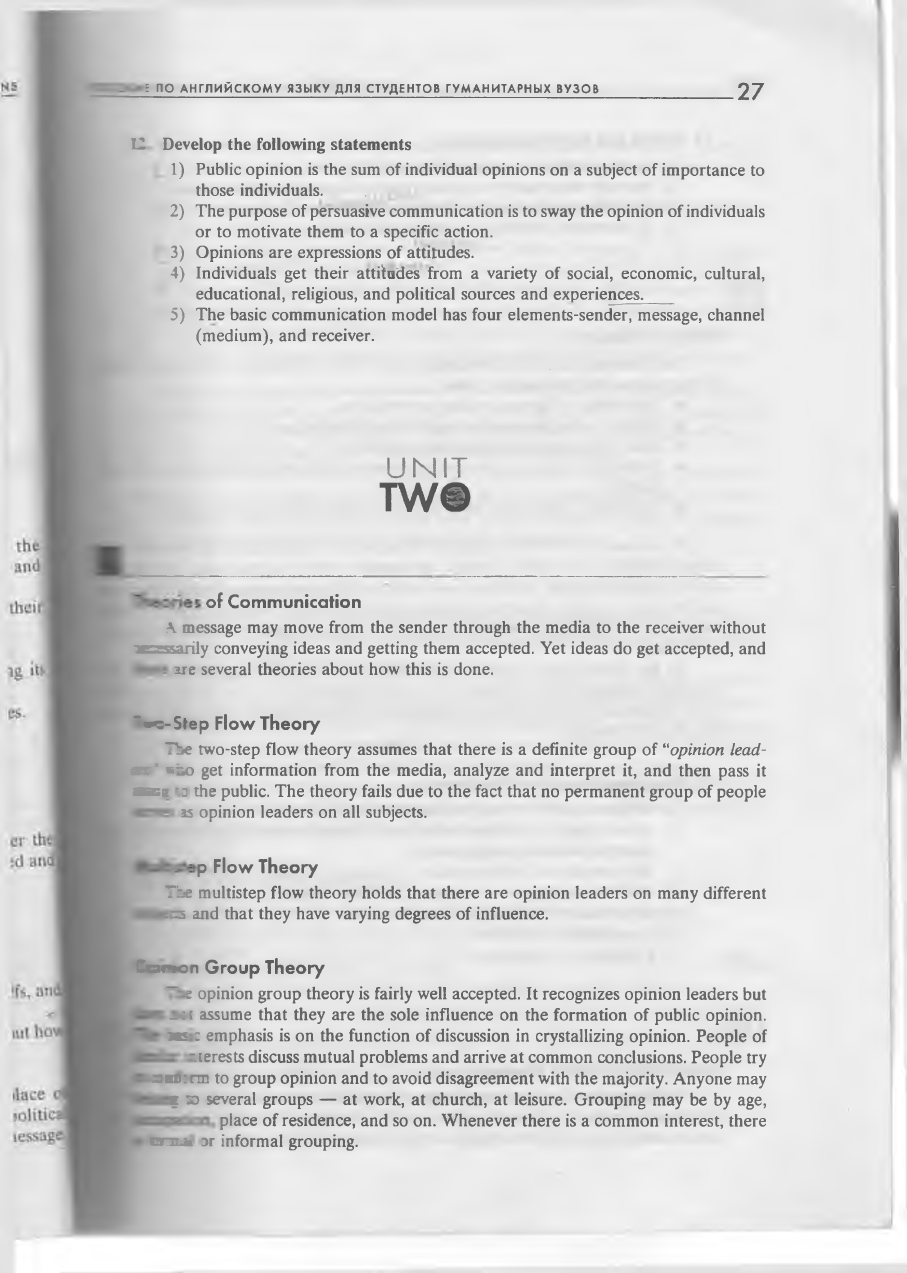
Е
1 0 А Н Г Л И Й С К О М У Я З Ы К У Д Л Я С Т У Д Е Н Т О В Г У М А Н И Т А Р Н Ы Х В У З О В
27
11 Develop the following statements
1) Public opinion is the sum of individual opinions on a subject of importance to
those individuals.
.
2) The purpose of persuasive communication is to sway the opinion of individuals
or to motivate them to a specific action.
3) Opinions are expressions of attitudes.
4) Individuals get their attitudes from a variety of social, economic, cultural,
educational, religious, and political sources and experiences.
5) The basic communication model has four elements-sender, message, channel
(medium), and receiver.
.
U N I T
TW©
of Communication
\ message may move from the sender through the media to the receiver without
asczssarily
conveying ideas and getting them accepted. Yet ideas do get accepted, and
ire several theories about how this is done.
'♦c-Step Flow Theory
ТЪе two-step flow theory assumes that there is a definite group of
“opinion lead-
лиг* *bo get information from the media, analyze and interpret it, and then pass it
ш г : *: the public. The theory fails due to the fact that no permanent group of people
is opinion leaders on all subjects.
ip Flow Theory
Tbe multistep flow theory holds that there are opinion leaders on many different
r r j and that they have varying degrees of influence.
l o n c n Group Theory
e opinion group theory is fairly well accepted. It recognizes opinion leaders but
- : : assume that they are the sole influence on the formation of public opinion,
ж : emphasis is on the function of discussion in crystallizing opinion. People of
-_:erests discuss mutual problems and arrive at common conclusions. People try
s n r : nn to group opinion and to avoid disagreement with the majority. Anyone may
,jfc> several groups — at work, at church, at leisure. Grouping may be by age,
place of residence, and so on. Whenever there is a common interest, there
щ -TLh. эг
informal grouping.